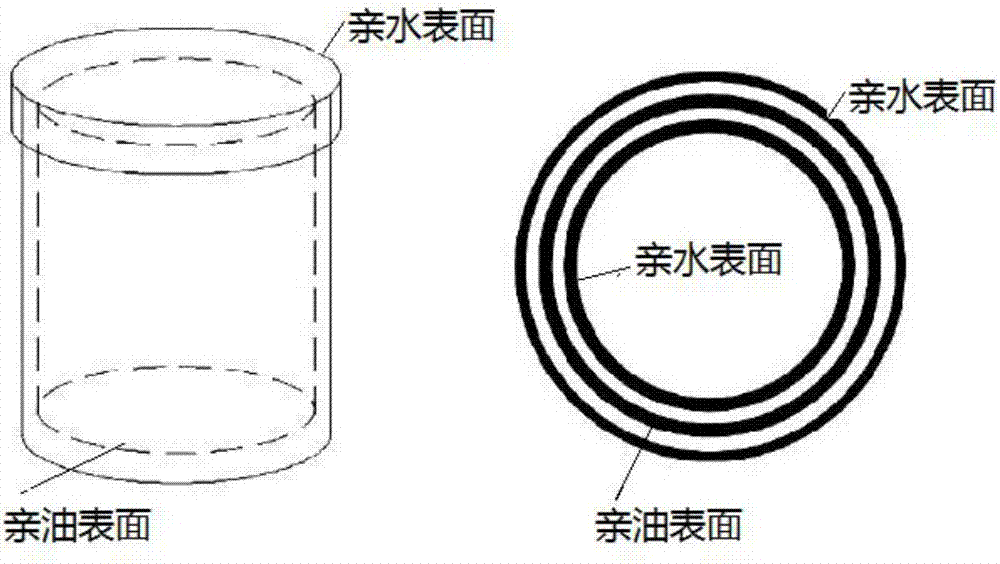Liquid-liquid separation method constructed by cylindrical soil surface force field differences
A solid surface, differential technology, applied in separation methods, liquid separation, chemical instruments and methods, etc., can solve problems such as device blockage, achieve the effect of increasing the separation area and increasing the separation effect
- Summary
- Abstract
- Description
- Claims
- Application Information
AI Technical Summary
Problems solved by technology
Method used
Image
Examples
Embodiment 1
[0030] A copper cylinder is used for the tube material A, and it is placed in NaOH and K 2 S 2 O 8 After soaking in the solution, a uniform needle-like copper hydroxide film is formed on the Cu surface, and then soaked in an ethanol solution of n-dodecyl mercaptan to obtain a copper cylinder with superhydrophobicity and superlipophilicity. The contact angle of the copper cylinder with water is 151°.
[0031] The cylinder material B is a stainless steel cylinder, and the surface is coated with a thermosetting resin solution. After the solvent evaporates, the silicon carbide powder is sprayed on the surface, heated and solidified to form a silicon carbide hydrophilic and oleophobic surface coating.
[0032] According to the technical principles and schemes of this patent, the cylinders A and B after surface modification are figure 1 Relatively arranged, the spacing is between 1um ~ 1000um, preferably 100um, allowing the oil-water mixture to pass between the cylinders A and B. Due to ...
Embodiment 2
[0034] A copper cylinder is used for the tube material A, which is etched with 4mol / L nitric acid solution for 4min, and then soaked in hexadecyl mercaptan with a concentration of 1mmol / L for 1hr to make superhydrophobic and super lipophilic copper The contact angle of the net, copper cylinder and water is kept above 150°.
[0035] The cylinder material B is a stainless steel cylinder, and the surface is coated with a thermosetting resin solution. After the solvent evaporates, the surface of the silica powder is sprayed and heated to cure to form a silica hydrophilic and oleophobic surface coating.
[0036] According to the technical principles and schemes of this patent, the cylinders A and B after surface modification are figure 1 Relatively arranged, the spacing is between 1um~1000um, preferably 200um, allowing the oil-water mixture to pass between the cylinders A and B. Due to the difference in the force field between the surface of A and B on the surface of the oil and water, ...
Embodiment 3
[0038] A stainless steel cylinder is used as the tube material A, and a layer of vertically arranged carbon nanotubes is deposited on the stainless steel by thermal chemical vapor deposition. Because the carbon nanotubes are hydrophobic, they have superhydrophobicity.
[0039] The cylinder material B is an ABS resin cylinder and sprayed on its surface with a polyvinylpyrrolidone solution to form a hydrophilic and oleophobic surface coating.
[0040] According to the technical principles and schemes of this patent, the cylinders A and B after surface modification are figure 1 Relatively arranged, the spacing is between 1um~1000um, preferably 500um, allowing the oil-water mixture to pass between the cylinders A and B. Due to the difference in the force field between the surface of A and B on the surface of the oil and water, different adhesion forces are generated, and the passing Liquid and static to achieve oil-water separation.
PUM
 Login to View More
Login to View More Abstract
Description
Claims
Application Information
 Login to View More
Login to View More - Generate Ideas
- Intellectual Property
- Life Sciences
- Materials
- Tech Scout
- Unparalleled Data Quality
- Higher Quality Content
- 60% Fewer Hallucinations
Browse by: Latest US Patents, China's latest patents, Technical Efficacy Thesaurus, Application Domain, Technology Topic, Popular Technical Reports.
© 2025 PatSnap. All rights reserved.Legal|Privacy policy|Modern Slavery Act Transparency Statement|Sitemap|About US| Contact US: help@patsnap.com

